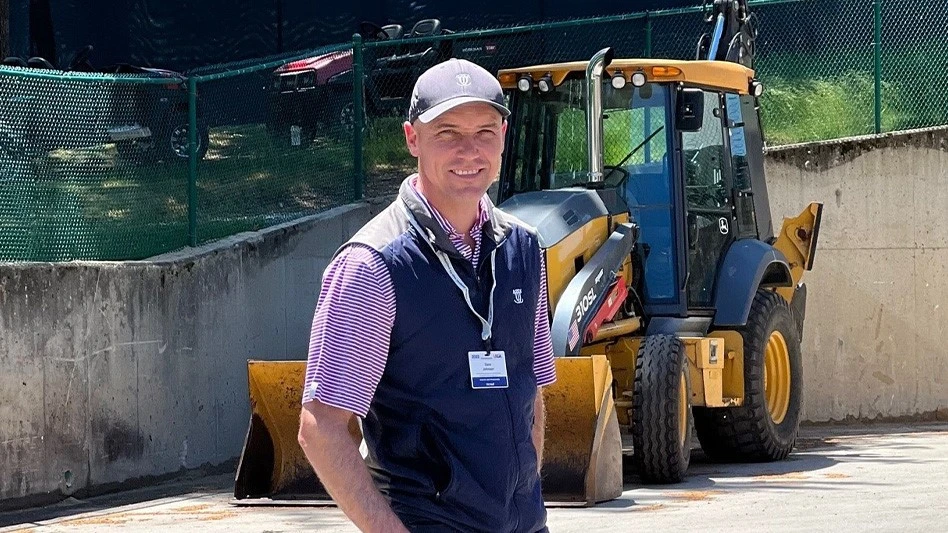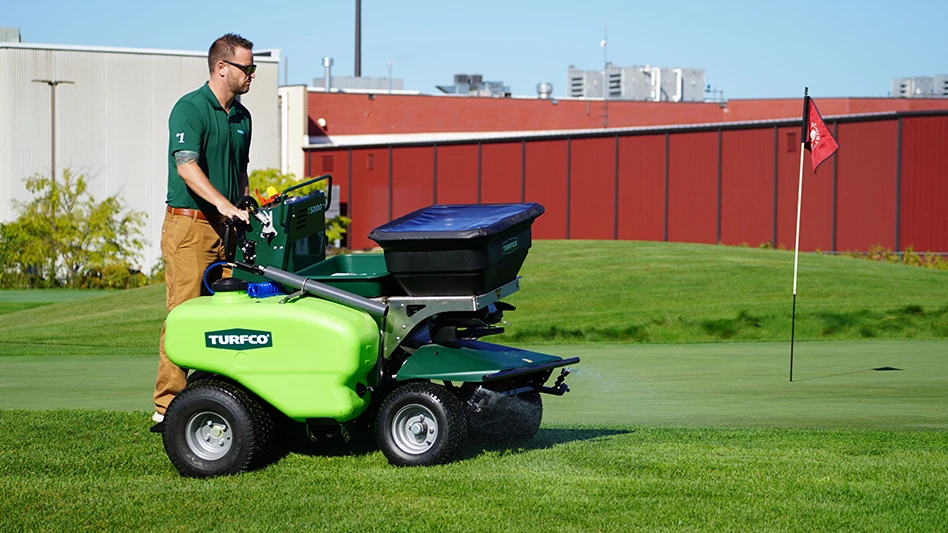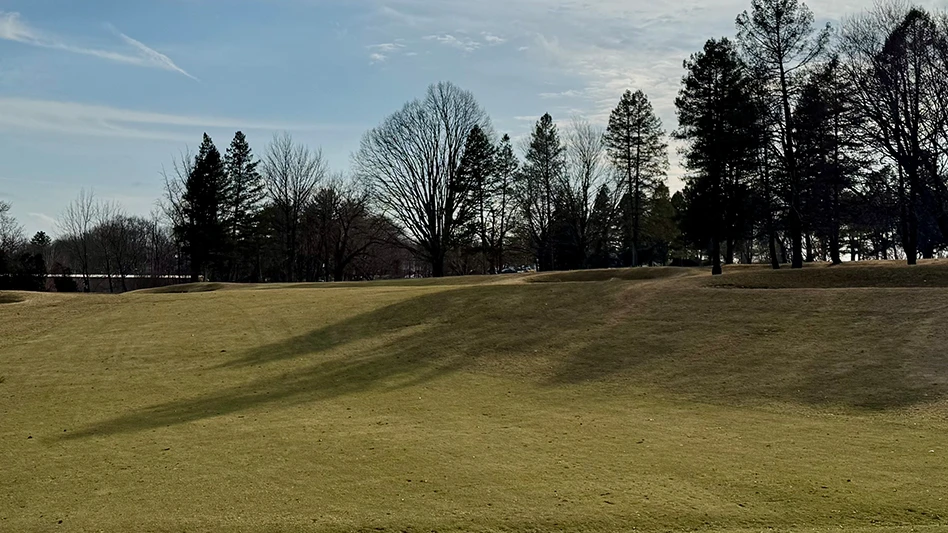
Dave Johnson led a four-person maintenance team eight years ago at a 9-hole course in a sleepy central Massachusetts former mill town. Now, he’s in charge of a legendary 27-hole club in a tony Boston suburb with a full-time crew of 36 preparing to host the U.S. Open
Careers take many different paths. Johnson’s has been on an upward trajectory for 25 years. When the USGA sets up its tents — actually, a temporary stadium — June 16-19 in Brookline, Massachusetts, for the 122nd U.S. Open, Johnson will be responsible for his first big-time championship.
No worries there on the part of the country’s ruling body of golf. “He’s extremely organized, outwardly calm,” USGA director of championship agronomy Darin Bevard says. In the three years they have been working together in the run-up to this year’s national championship, Bevard has come to appreciate Johnson for his open-mindedness, willingness to ask questions and responsiveness to requests — even when it appears that there’s need for adjustment in mowing lines, trimming trees, or on-course traffic patterns. “He’s always asking a lot of questions. He’s always interested in learning,” Bevard says.
The fact that Johnson has no direct experience with prepping for his own major, let alone a U.S. Open, has never been an issue. For one thing, Johnson has been a regular visitor to USGA championship setups since he arrived at The Country Club in 2018 and attended that year’s U.S. Open at Shinnecock Hills.
Bevard has been working with superintendents at majors for 15 years and has a perceptive take on those who exude outer confidence versus those who run deeper in their thinking. “The guys who say they get it don’t,” Bevard says. “The guys who ask a lot of question get it.”
Johnson, 47, has been asking questions of recognized industry experts for years now.
A native of Worcester, Massachusetts, Johnson earned a degree in plant and soil science in 1997 from the University of Massachusetts at Amherst. He was assistant superintendent at Wachusett (Massachusetts) Country Club for seven years, then took the head job at 9-hole Whitinsville Golf Club in 2004, where he stayed for a decade. The Donald Ross-designed gem from 1923 is widely regarded among architecture purists as among the best examples of virtually original Ross work.
Johnson started seeing a regular stream of course raters from various magazine panels stop by. In 2009, Whitinsville had the foresight to hire Gil Hanse to map out a master plan of restoration. The experience of accompanying Hanse and his design associate around the course was “an eye-opener,” Johnson says. The restoration work involved minimal intrusion limited to tree work, expanded fairway lines, greens recapture and bunker edging. Along the way, Johnson complemented his agronomic expertise with a master class in architectural subtlety.
“I learned a lot from Gil” Johnson says. “Humility, respect for the land, not to bite off more than I could chew. Learned about the relation of the fill pad to bunkers, about the importance of fairway contours.”
He also learned how to do green expansions. Johnson recalls the first time he undertook an expansion under Hanse’s tutelage. “We were on the first green at Whitinsville,” Johnson says. “We needed more room for a hole location on a very sloped surface. We had a few guys with us with rakes and shovels. Gil started up the sod cutter and tore into that back portion. After a while he turned to me and said, ‘OK, you guys can finish it from here.’”
One manifestation of the work: Whitinsville made it onto Golfweek’s Top-100 Classical List. It has been a stalwart ever since.
Johnson, meanwhile, had his eyes opened to a larger world of possibilities. With a modest club budget to start and the effects of the recession still restricting what was possible at Whitinsville in terms of major bunker work, Johnson started casting about for other job opportunities. Good fortune hit in 2014 with Wianno Club in Osterville, Massachusetts. It helped to have a recommendation from Hanse, who had already been hired by Wianno for restoration work. But the kicker in Johnson getting the job, he says, is the visit the search committee made to Whitinsville the day after he interviewed for the new post.
“We were in the maintenance shop,” Johnson says. “One of the search committee members opened a drawer in my toolbox. He took one look at how everything was perfectly organized, neat and clean. He closed it right away, but I knew I had the job. Turns out I was my own mechanic there at Whitinsville and I’m a particularly anal person when it comes to stuff like that. I knew where every tool was in the shop.”
In his four years at Wianno, Johnson again worked closely with Hanse, this time on an ambitious master plan that involved green expansion, major tree work and a complete overhaul of the bunkers.
Wianno is one of those old line, well-established clubs with considerable ties to The Country Club through shared membership. When the job in Brookline opened, Johnson joined a long list of applicants. But what he might have lacked in experience setting up for majors he more than compensated for with his record of meticulous care and respect for making the golf course better.
Now he’s about to build that resume with a U.S. Open. He’s made the adjustment to managing 36 full-time employees, with a volunteer crew of another 100 about to back him up for the week. The golf course has seen a big improvement these last three years in the growing environment. Working yet again with Hanse on a restoration program, Johnson and the club added 40,000 square feet in surface to its push-up greens. The leading edges of the bunkers have been reshaped to allow for tighter integration with fairway-height mowing cuts rather than being saddled with a heavy collar of surrounding rough. And a short, drop-shot par 3 has been completely restored that will play as the 11th hole.
It's funny in golf, how skills you learn early in your career form the basis of ongoing learning and adaptation. What served as an “eye-opener” 15 years ago are what now allow Johnson to get ready for one of the biggest events in golf.
Bradley S. Klein, Ph.D., is a former PGA Tour caddie, a veteran golf journalist, a noted author (“Discovering Donald Ross” among others), a golf course consultant and the Golf Therapy columnist for Golf Course Industry.
Get curated news on YOUR industry.
Enter your email to receive our newsletters.Latest from Golf Course Industry
- Atlanta Athletic Club approves funding for master plan
- Maximizing Cultural Practices and Agronomic Benefits with Minimal Surface Disruption
- Real Answers about Spray Nozzle Choices
- From the Course to the Factory: How Customer Insights Drive Innovation
- New & Proven Enzyme Strategies for Sprayable Thatch Management
- Innovating Tomorrow: Wittek’s New Products & Industry Staples
- PBI-Gordon introduces new field development team
- The Cabot Collection announces move into course management





